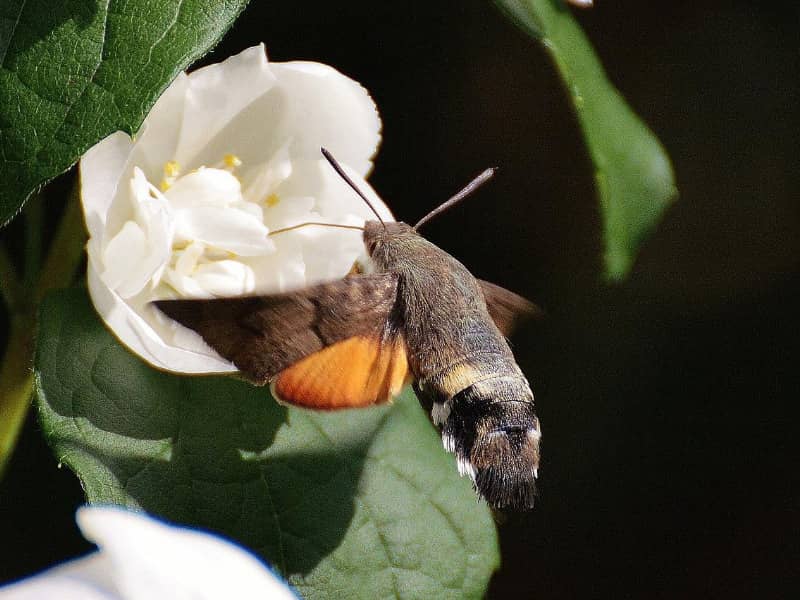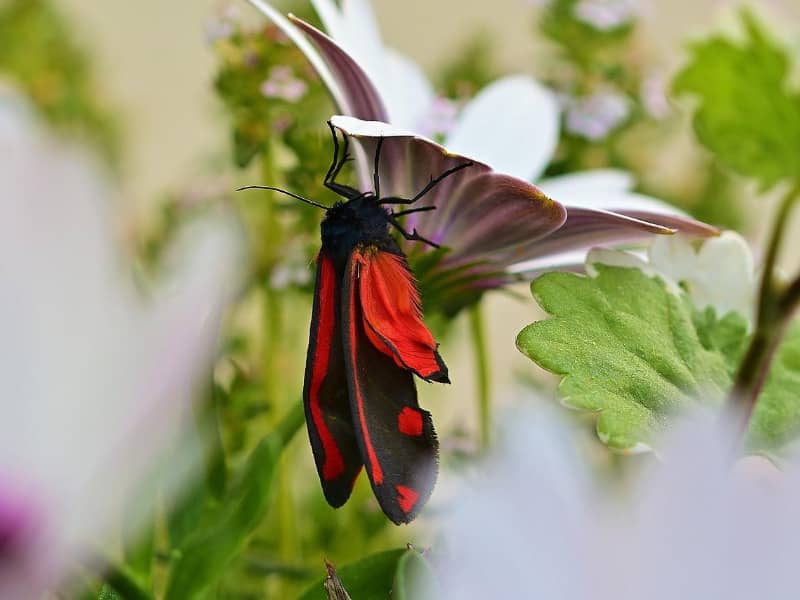
Pigeon tails - a hummingbird in Germany?
If you should discover a hummingbird in Germany, then this will probably be a pigeon tail. However, the dovetail is a moth and belongs to the butterfly family. Just like a hummingbird, the dove tail can stand in mid-air in a buzzing flight and even fly backwards. Originally native to the Mediterranean, these extraordinary animals are seen more and more often in our country.
Pigeon tails, the features
The dove's tail got its name because it has a divided hind part, which is marked with white spots. Thus, with a little imagination, it looks similar to a dove's tail. However, the butterfly does not have feathers, but they are elongated scales that help the pigeon tail to quickly and, above all, specifically control its flight movements.
The animal has a wingspan of 5 cm and in exceptions 6-7 cm. This occurs mainly in Asian areas. The butterfly, which is also called hummingbird hawk moth, can fly both forward and backward. Other moths or butterflies cannot do this in this form. In addition, it can stand excellently in the air and thus drink nectar with its approximately 3 cm long proboscis even from deep flowers.
The body of the animal is stocky and insistent on the front part. The color is gray-brown and it has white tufts of hairs at the anterior base of the wings. The antennae are club-shaped and thicken forward.
Where does the dove tail come from?
The pigeon tails that we see in Germany all come from southern Europe. This is because the pigeon tail is a migratory butterfly and comes to Germany from southern Europe in the months of May to July. Almost always the way over the Alps is chosen. Regularly the butterfly was seen from the mid-1990s in southern Germany, because there the climate was ideal for this butterfly species mainly in the Rhine valley.
With the warming of the climate, the animal has ventured further and further north. Thus, in 2003 and 2006, pigeon tails were also sighted in northern Germany. However, these two summers were extremely hot and it is the exception that the animals migrate so far north. In the meantime, the pigeon tails have settled in southern Germany and overwinter here as well.
The animal has a large range, extending from Portugal and the north coast of Africa to northern Russia and Southeast Asia. Isolated specimens have even been discovered on Iceland.
What does the pigeon tail feed on?
The animal has the longest proboscis among diurnal insects that feed on flower nectar. It reaches a length of up to 30 mm, so the pigeon tail can drink from flowers that are inaccessible to other insects. This is a great advantage for the animal, because it gives it a food supply that does not have to be shared with others.
Another advantage of the long proboscis is that the butterfly does not have to get too close to the flowers. This protects it from predators that use the flowers as cover to hunt the moths. Anyone who has observed a pigeon tail feeding will be impressed by its speed. Its stay at each flower is only a few seconds and scientists have observed that it can visit up to 100 flowers in 5 minutes.
When choosing flowers, the dove's tail is very flexible. Although it prefers flowers with deep calyxes, other flowers are also used. The plants it most often targets are cranesbill, petunia, phlox, knapweed, summer lilac, bindweed and viper's bugloss.
Way of life of the butterfly
The pigeon tail is a diurnal animal, but belongs to the group of moths. They are robust and so you can see them regularly looking for food even in rainy weather. In principle, the animals like the heat, but they try to avoid great heat. This is the reason why observations of the animal can be made mostly in the morning and evening.
As a sleeping place, the animals often use stones and sometimes house walls, which are warmed by the sun. There they gather in groups to rest together. At these places also the mating of the pigeon tails takes place. They often lay their eggs on bedstraw and chickweed. These plants are excellent food for the caterpillars.
A caterpillar of the butterfly grows about 5 cm long and is green in color. The caterpillar has two longitudinal lines and small yellow-white dots. After about 20 days and just before pupation, the color of the pupa changes to reddish brown or even slightly purple. The moths from the May to July oviposition hatch in September and October and are almost always descendants from the immigrant population that comes over the Alps in the spring.
Between three and four moth generations occur each year. The Life expectancy of a flying butterfly is about four months. The animals survive the winter in a protected place as moth and pupa. In Germany, there are only a few places where this is possible for the pigeon tail. Most of them are located on the Upper Rhine, where a particularly mild climate prevails even in winter.
The wanderings of the butterfly
Most of the animals come over the Alps to Germany in spring. For this route, they take on considerable strain. The small bundle of energy shows here extraordinary achievements. Thus, distances of 2000 to 3000 km are not uncommon on their wanderings. During their migrations, the pigeon tails reach speeds of up to 80 km/hour.
The animals that migrate to us in spring are the first and second generation of the year that hatched in the south. To date, however, it is not known for certain where the moths migrate to during the onset of winter in Germany. It is known that some of them overwinter here, but it is not conclusively clear whether the rest of the population migrates back to the south.
The dove tail in your garden
Pigeon tails are extremely flexible and can find their food in a city garden, on a balcony or even in large open spaces. The only thing they don't like is dense stands of trees. So you will find pigeon tails in the forest only extremely rarely, also parks with a dense tree population are avoided by them.
The animals seem to have an excellent memory and once they have settled somewhere, their radius is limited to a few square kilometers, provided the food supply is right. So they come back again and again to food sources known to them and also look for their resting and sleeping places again and again.
So you can assume that once you have a pigeon tail in your garden and can offer it a good food supply, it will keep coming back. The animal is an excellent pollinator. As we described above, it can visit up to 100 flowers in 5 minutes, making it more effective than any other insect.
Author

-
Garden animal - A life with nature
Welcome to my animal blog! My name is Dirk and I am happy to take you on my journey through the fascinating world of animals and gardening.
Born 54 years ago, I have had an insatiable curiosity for the animal world around me since childhood. Although I have moved professionally in other industries, my true passion has always been animals and nature. It is remarkable how a small garden has become such an important part of my life.
Many of my fondest memories are associated with the animals that share our home. Whether it's the curious squirrels that scurry across the trees in the morning, the colorful variety of birds that visit our feeders, or the busy bees and butterflies that pollinate our flowers, every moment with them is invaluable to me.
This blog is my contribution to share my experiences, discoveries and insights with like-minded people. Here I will share stories of unforgettable encounters with animals, give tips on gardening and creating wildlife-friendly habitats, and take you on my journeys through nature.
Thank you so much for being here!
Cordial,
Dirk aka garden animal
Last posts
- 27. February 2024PetsVeganes Hundefutter – Grün und Gesund?
- 18. January 2024ChickensOregano für Hühner
- November 27, 2023HamsterDiurnal hamsters
- November 24, 2023HamsterHamster hammock

